In Praise of Great Mezcal: All Tequila is Mezcal, But Not All Mezcal is Tequila (and Avoid the Worm)
by Ken Gargett
A confession. My generation, growing up in Australia, knew little about tequila, and far less about mezcal (aka mescal). We knew that tequila was necessary for a classic cocktail, the Margherita, although – and I am not making this up – half the bars at the time had no idea if the rim should be dipped in salt or sugar. That made for some really weird margaritas. We knew there was no such thing as decent tequila – it was all on par with battery acidity (I didn’t say we were correct in what we thought we knew).
Finally, we knew that if you were really lucky and got a really high-class bottle of tequila, you might find a worm. And as every young university student knew, swallowing a tequila worm was part of coming of age.
In other words, we knew nothing. About mezcal? Even less.
In the intervening years, we have learned that there are some truly superb tequilas and none will have a worm. The worm is to be found in really dodgy bottles of mezcal. We have come a long way.
We will be looking at tequila in more depth in the next few weeks, but today, mezcal.
And speaking of worms
First up, the worm. Tequila does not, and apparently has never had, a worm swimming around inside a bottle. That is mezcal, although not every mezcal, and certainly not in the top-shelf stuff. Technically, it is not even a worm, but a caterpillar, a moth larvae known as a red maguey worm.
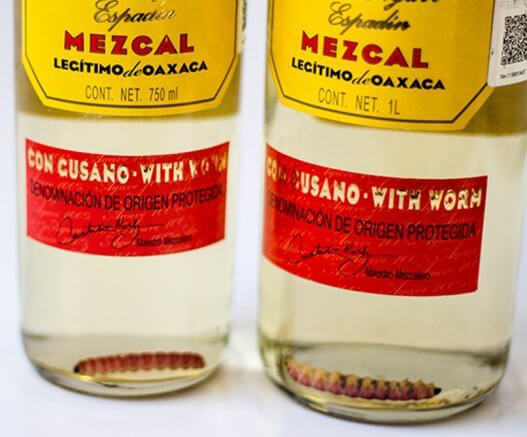
If there’s a worm, you may want to find another brand of mezcal
If not preserved in alcohol and swallowed by students, this larvae would become a Comadia redtenbacheri moth. The larvae, which infests the heart and roots of agave plants, are regularly consumed in Mexico, without any of the drowning them in alcohol or with the endless fuss and University-level chest-beating. Some even consider them a delicacy, using them in soups, tacos, or as crisp fried snacks.
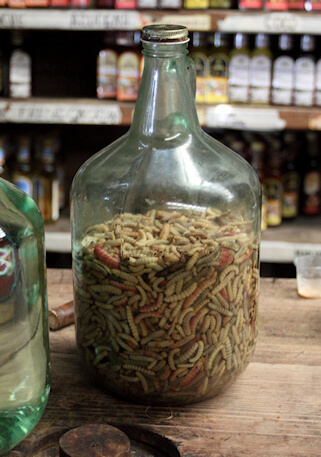
Gusano de Maguey worms ready to be added to bottles of mezcal (photo courtesy vnsaum75/Wikipedia)
The worm in the bottle was a marketing concept designed to encourage tourists to drink more mezcal. Well, more accurately, to encourage tourists to drink more really awful mezcal. It was not something in which one would find locals partaking.
In fairness, it is entirely possible that there are bottles of mezcal with worms that are not too bad. For me, the search continues. While dispelling myths, this is not a hallucinogenic spirit.
Bottom line. If your bottle has a worm, it will be mezcal, and probably very ordinary mezcal. It is not even legal to put a worm in tequila.
————————————————————————————————————–
—————————————————————————————————–
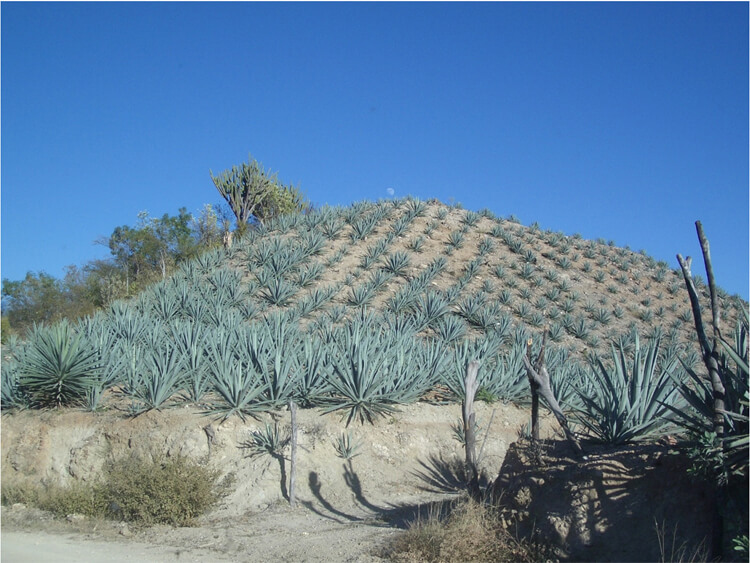
A typical agave tequilana plantation (photo courtesy Agave/Wikipedia)
All tequila is mezcal but not all mezcal is tequila
If we take our leave from the worm, technically, all tequila is mezcal but not all mezcal is tequila. Tequila must be made from at least 51% of the blue agave plant (agave tequilana), whereas mezcal can be made from more than thirty different varieties of agave.
Most mexcals, an estimated 85 to 90%, are from the agave Espadin. For the record, the agave is not a cactus, but rather a desert succulent.
Interest in mezcal has exploded in markets like the United States. Others have been a little slower to get on board but it is happening. And that is thanks to the top shelf, artisanal craft efforts. Not a worm in sight (okay, I promise that I shall not mention worms from here on in).
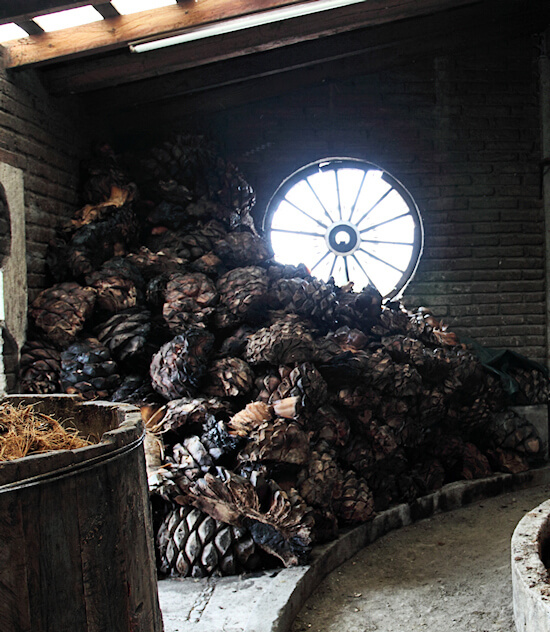
Roasted agave (maguey) hearts ready for milling (photo courtesy Nsaum75/Wikipedia)
To produce mezcal, speaking in the most general sense, the hearts of the agave plant, used for the distillation of mezcal, are roasted in underground pits for between three and five days (for tequila, they are cooked in brick ovens), crushed, fermented in vats, and then distilled to between 72 and 110 proof, but the consensus is that 90 is the bare minimum for quality.
Distillation is then in copper stills or clay vessels, the latter considered to give a more authentic, earthier character to the spirit. Pechuga is a form of mezcal that has been infused with other flavors, a story for another day.
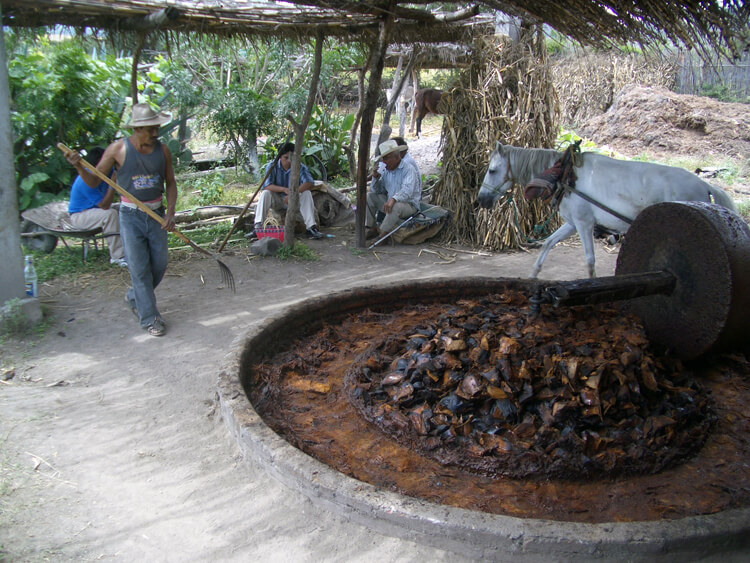
Molino de maguey roasted agave grinding mill (photo courtesy Agave/Wikipedia)
—————————————————————————————————–
—————————————————————————————————–
There are three official designations of mezcal, ‘Industrial’, ‘Artisanal’ and ‘Ancestral’. The top producers use only the last two methods. For those, pits are used; milling must be by a tahona (donkey or horse-powered) mill or hand smashed (electric mills are permissible for ‘Artisanal’); and fermentation is in vats which must be stone, wood, masonry, clay or leather (stainless steel is permitted for ‘Industrial’).
Distillation is heated by fire in a clay pot base for ‘Ancestral’. Copper is permissible for ‘Artisanal’.
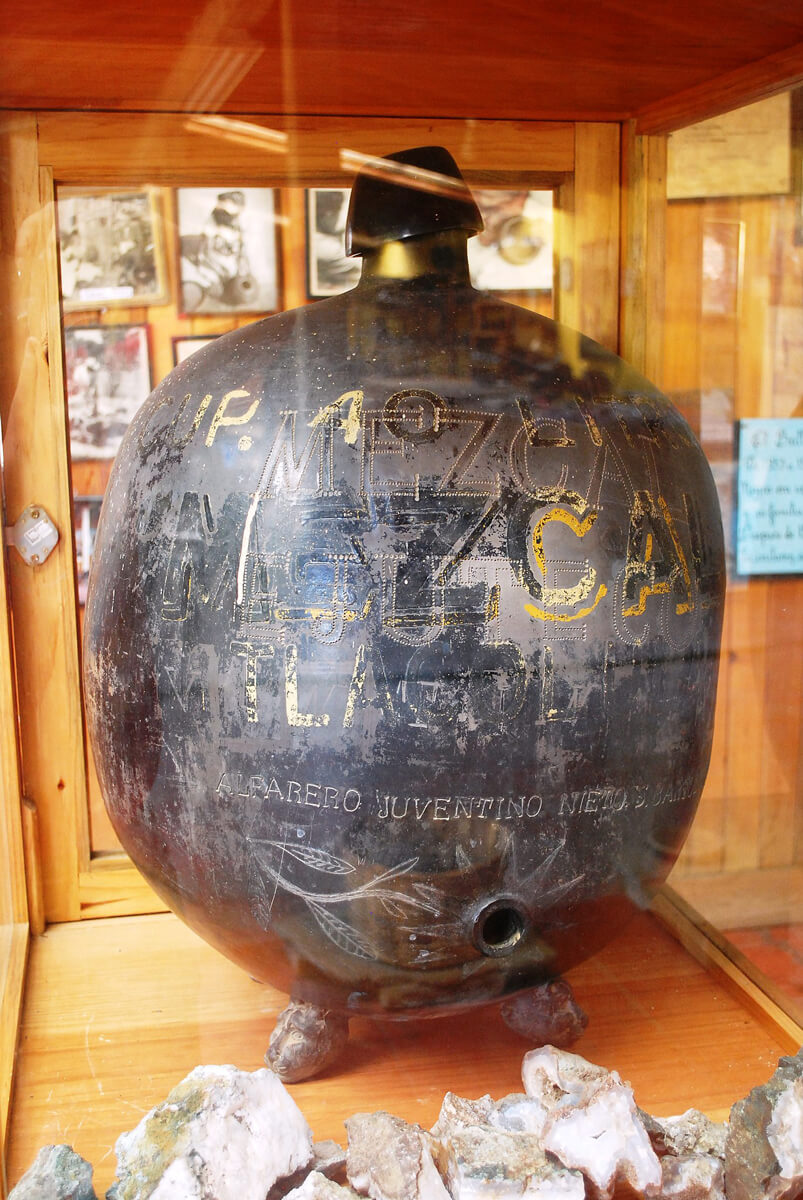
Cantaro jar for serving mezcal at the Doña Rosa Workshop in San Bartolo Coyotepec, Oaxaca, Mexico (photo courtesy AlejandroLinaresGarcia/Wikipedia)
It is believed that the name, ‘mezcal’’, comes from a Nahuatl term, ‘mexcali’, which means ‘cooked agave’. An agave heart is a serious beast, some even topping 100 kilograms.
To drink it neat, with a little ice or as part of a cocktail is entirely up to the consumer. The cheaper versions really demand the opportunity to hide, so cocktails it is, although the better the spirit, the better the cocktail. The good stuff? Sip it.
Mezcal has a problem. The agave is not like a grapevine, producing every year. Production is not like stripping a juniper bush of its annual production and coming back next year. The common agave we mentioned, the Espadin, takes a decade to mature, give or take a few years.
The piña, the core/heart used for distillation, of each agave plant eventually yields just ten bottles, again give or take. Not much for a decade’s work. The Tepeztate agave takes a quarter of a century.
The Tobala, and take note as we will be coming back to this plant, is a very small version of the agave that grows under oaks on high-altitude slopes. It takes about fifteen years and each piña yields around two bottles. It also exudes an enzyme which can break down granite.
It is hard to imagine that with such lengthy periods of time necessary for production, and such small yields, combined with the explosion of interest in mezcal that we will not see some serious price hikes. The truth is that this stuff is already seriously expensive. As one friend says, ‘cognac prices’. I know, always with the negativity.
—————————————————————————————————–
—————————————————————————————————–
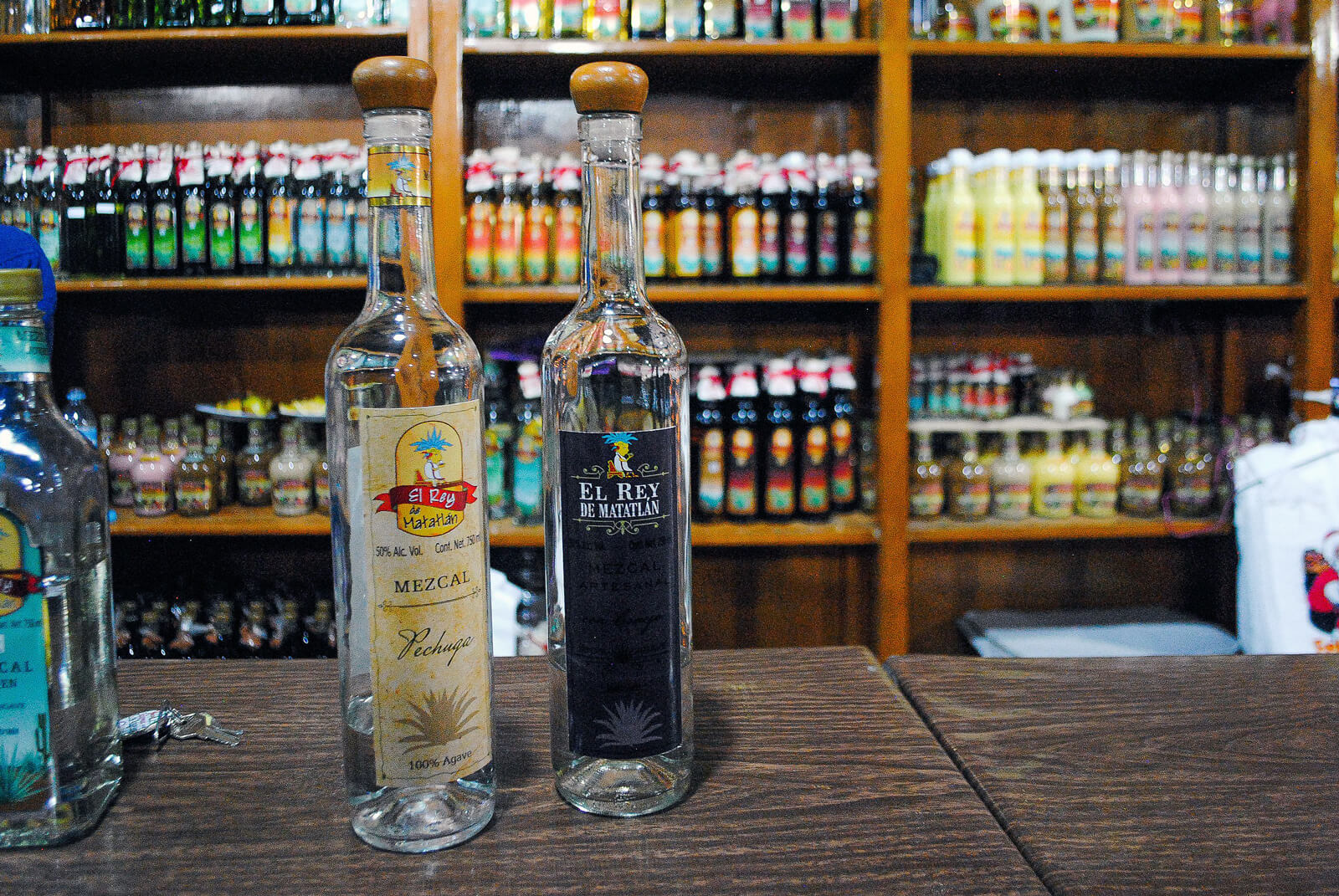
Mezal, mezcal and more mezal! (photo courtesy ProtoplasmaKid/Wikipedia)
In places like Oaxaca in Mexico, there is anything but negativity. An article in the New Yorker by Dana Goodyear described how mezcal was “medicine and social glue”. As one local said, “It makes you cry, sing, dance, hug the neighbor you just met an hour ago—and then your soul rests.” How can that not excite you?
Several decades ago, mezcal got a boost as some famous American artists took to it (perhaps, given what else they may have indulged in, this is where the myth of it being hallucinogenic had its genesis). They had access to the good stuff. Of course, as with all spirits, there are ways to take shortcuts in production, to produce the stuff on an industrial scale.
Naturally, these mezcals are virtually unrecognizable from the small batch, artisanal efforts. It is, after all, not that long ago that mezcal had been banned and makers sold bootleg versions from portable stills. By 1994, however, the government had created a D.O. for mezcal (largely replicating the regulations in place for tequila).
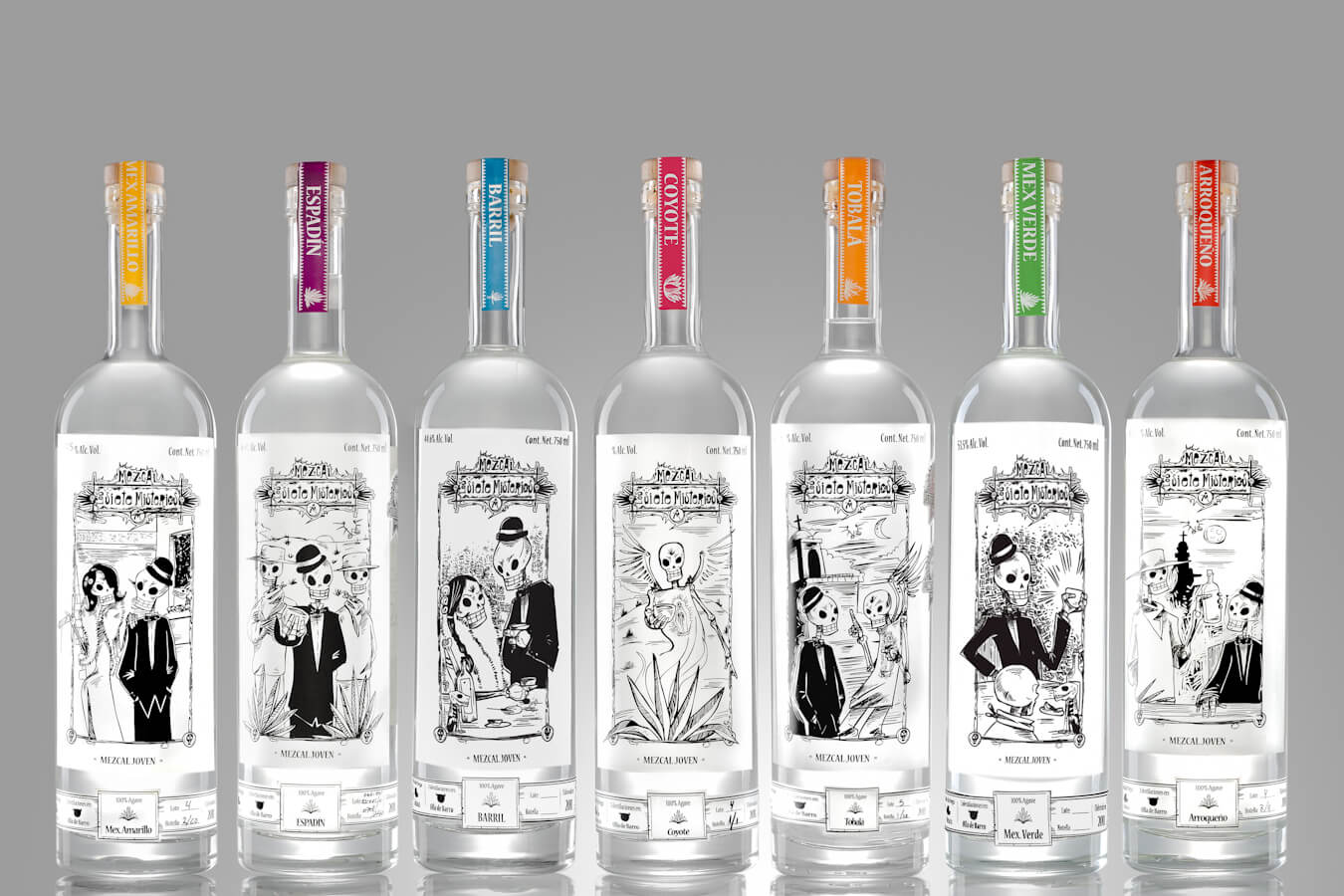
Bottles of Siete Misterios mezcal
Mezcal has also had a boost from Día de Muertos, the Day of the Dead, held on November 2nd. Graves are decorated with flowers – mostly marigolds – and other items including tequila and mezcal. No doubt plenty is also consumed during the celebrations.
—————————————————————————————————–
—————————————————————————————————–
Mezcal production
Mezcal can only be produced in eight specified regions throughout Mexico, according to the laws. These are Oaxaca, Durango, Guanajuato, Guerrero, San Luis Potosi, Tamaulipas, Zacatecas, and Michoacán. Oaxaca is by far the most important.
It is estimated that around 94% of all mezcal is produced in the State of Oaxaca and that there are some 8,000 producers. Many of these make tiny quantities which are sold to companies who then offer them to the world.
Mezcal production is dwarfed by tequila, with an estimated 200 bottles of tequila produced to every one of Mezcal. But then most mezcal is made by local families, rather than huge distillers. The danger is government involvement, whether well-meaning or otherwise, which prioritises the larger distilleries and harms the craft aspect of the industry. The decision to reduce the minimum alcohol level to 35% ABV from 45% ABV is a decision seen as benefiting the large distilleries.
Sticking to artisanal producers and their quality mezcals will help in the fight against standardization. Surely, the world has enough nondescript, formless spirits. Ensuring the sustainability of a distinct, unique spirit like elite mezcal should be in the interests of all spirit lovers. Some producers have even gone so far as to export their spirits as “destilados de agave” rather than as mezcal, to avoid having to meet certain regulations which they believe deprive their products of their essential character.
One way that experts test whether or not they are dealing with quality, artisanal mezcal, rather than the mass-produced examples, is to put a drop or two on your hands and rub it around. If the smell is of the earth, vegetal, herbaceous and spicy with peppery notes, your mezcal is on the money. If you get notes of burnt rubber, candy, vanilla and artificial aromas, move on.
Mezcal taste
So how best to drink mezcal and of what should it taste? There are a few characters and flavors that are raised by all the experts. A complex, rich, smoky note. Some even compare the smokiness with the single malts from Islay though I find those malts somewhat more extreme – needless to say, there is some serious variation in levels of smoke.
The smokiness is believed to come largely from the method of cooking the hearts in the conical pits. There can be a grassy note and a minerally backing (if I had simply come across this description without knowing the subject, I would be thinking that whatever it is, it sounds perfect to enjoy with a Cohiba cigar). Good mezcal should be balanced, even subtle, and with length.
Worth keeping in mind that the alcohol level in good mezcal is often higher than in other spirits, sitting around 45% to 55%.

Spicy mezcal margarita (photo courtesy www.eatingwell.com)
As for how to drink it, cocktails are obvious – spicy margaritas are popular – but for the full mezcal experience, as with any great spirit, sipping solo (sip, don’t shoot, as they say) is the way to go. With cocktails, the bartenders talk about the combination mezcal offers with ginger and pineapple as well as lemon and lime.
Solo, experienced mezcal fans talk about the first sip refreshing the mouth, washing out any other flavors so that the second sip reveals the glories of the mezcal.
—————————————————————————————————–
—————————————————————————————————–
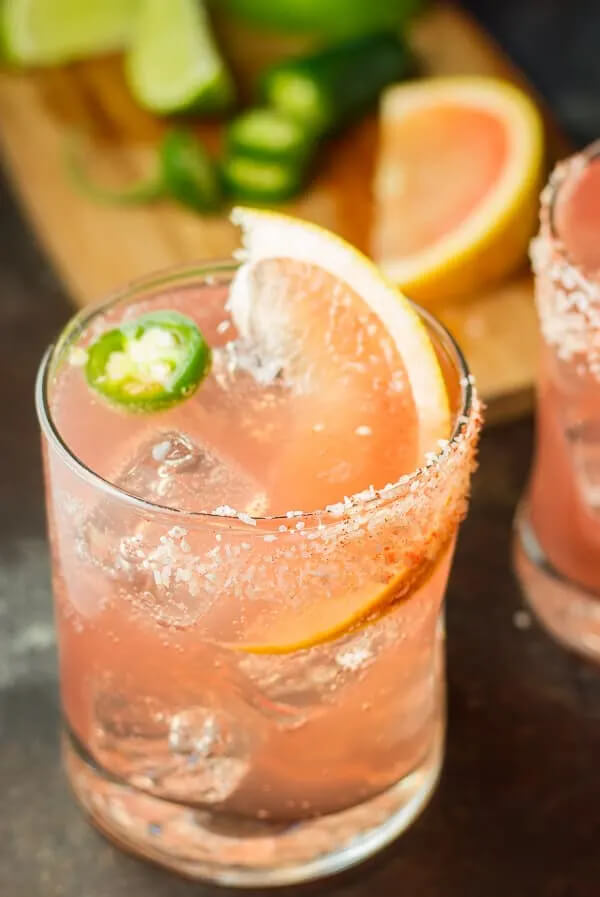
Mezcal grapefruit cocktail (photo courtesy www.thewickednoodle.com)
Think of tequila as the party girl grown up, while mezcal is still the wild child, occasionally disappointing but all too often a bit exciting, unexpected and fun. Another comparison I saw is that tequila is a loaf of sliced white bread, whereas mezcal is artisanal sourdough. It has been said that if you have lost religion, mezcal can bring you back. That might be a bridge too far for even the finest mezcal.
As mentioned, an American artist is credited with much of the original popularity of mezcal, especially in the States. That man was Ron Cooper and the business he established was Del Maguey, now in partnership with Pernod Ricard. Other highly regarded producers include Rey Compero, Los Nahuales, The Lost Explorer and Ilegal.
Siete Misterios mezcal
One name which has really been impressing lovers of fine mezcal is Siete Misterios. It was founded in 2010 by the brothers Mestre, Julio and Eduardo. The name means ‘seven mysteries’, there originally being seven different mezcals released. Like a number of the new wave of mezcal producers, they source artisanal spirit from traditional producers, known as mezcalero, in this case those which highlight a ‘single agave varietal’. This is small batch spirit production at its finest. As is inevitable, batches can vary. The team has set up an agave nursery with ten different species to ensure that their agave harvest is sustainable.
Some of their mezcals include ‘Arroqueño’, one of the oldest and largest of the agave plants. It can take twenty years before it is ready for harvest. This agave is both cultivated and found growing wild. Their ‘Doba-Yej’ is made from Espadin (Doba-Yej is the Zapotec word for Espadin), yet is different to the company’s Siete Misterios ‘Espadin’. It is distilled in copper, rather than the clay pots that Siete Misterios usually employ. Their ‘Pechuga infuses turkey breasts and spices, but with an annual production of just 500 liters, it is extremely rare.
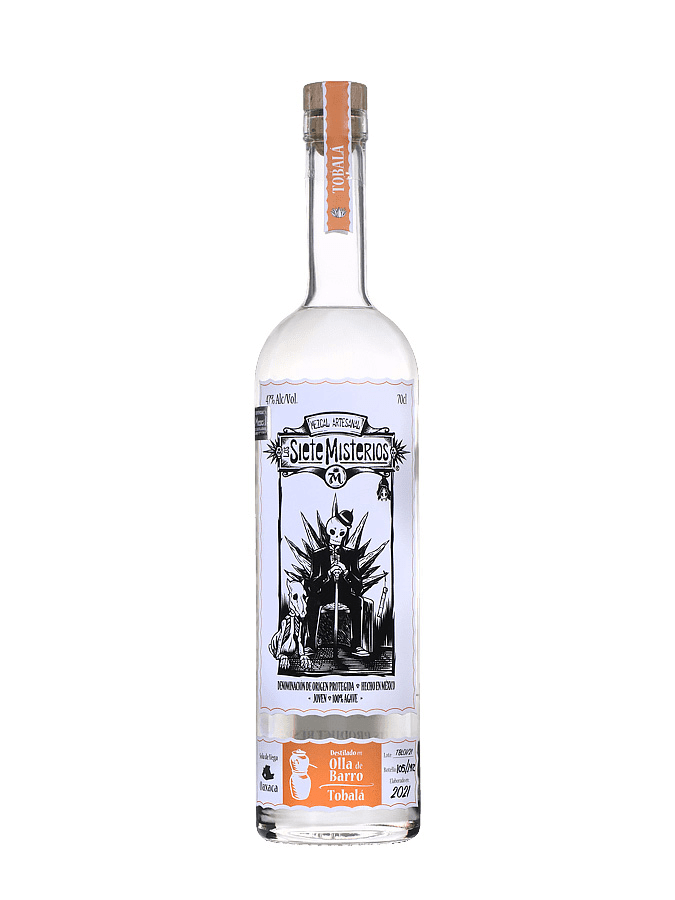
Siete Misterios Tobala mezcal
‘Tobala’, made by the ‘Ancestral’ method, uses the agave they consider the ‘crown jewel of agave varietals’. The Tobala agave only propagates by seed and is found in remote and difficult locations. The heart is very small for an agave.
The Siete Misterios Tobala is a world-class spirit and should be on everyone’s bucket list. The nose is a mix of clay and earth with hints of grassy notes. Fresh leather and florals. A touch of citrus. The palate has cloves, freshly grilled spices, a hint of coffee bean and an appealing lusciousness.
That traditional smokiness is lurking in the background on the nose but moves to the forefront on the palate. There is no hiding the alcohol here – a shrinking violet this is not – but it is well-balanced and the finish is very long. The price for a bottle was all over the place in Australia, between $200 and $500, depending where you look.
Elite mezcal will be a revelation for any spirit lover who is not yet familiar with its glories. It deserves close attention, rather than suffering the indignity of shots. Prices for the good stuff may initially surprise, but the technique of production is small scale and by hand. Mezcal may well be the hottest spirit on the market at the moment, but it seems that plenty of aficionados already knew that.
* This article was first published 30 January 2023 at In Praise Of Great Mezcal: All Tequila Is Mezcal, But Not All Mezcal Is Tequila (And Avoid The Worm)
You may also enjoy:
Monkey 47 Gin: From Failed Watchmaker To Making One Of The Best Gins In The World
Strange Laws In The World Of Wine And Spirits: The Good, The Bad, And The Idiotic







Leave a Reply
Want to join the discussion?Feel free to contribute!